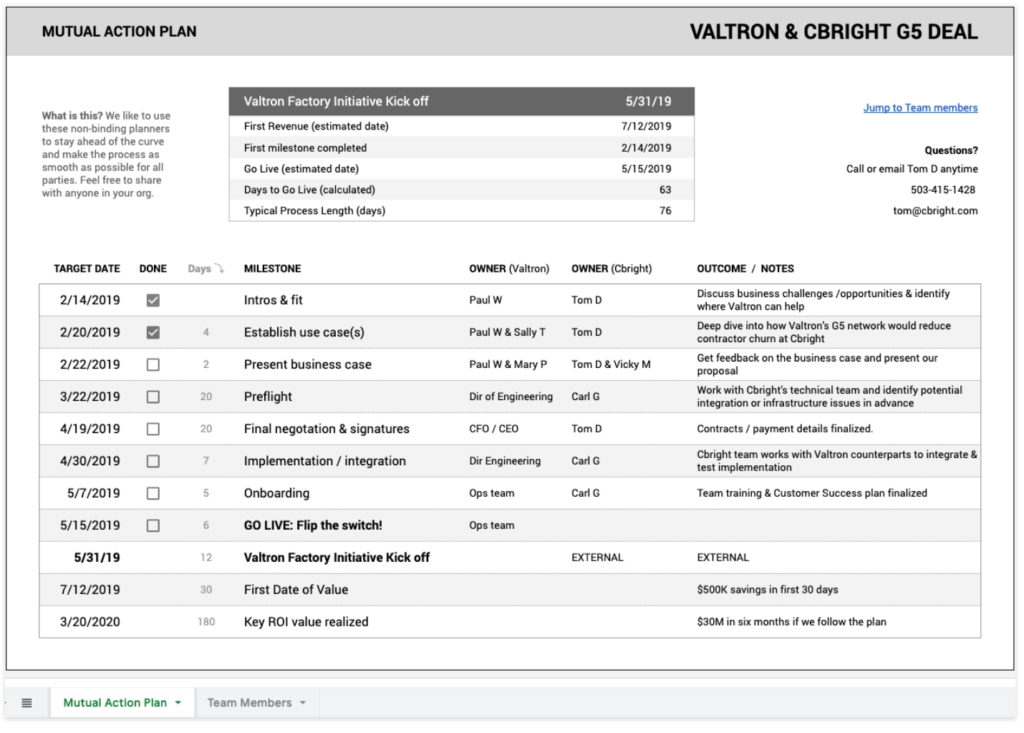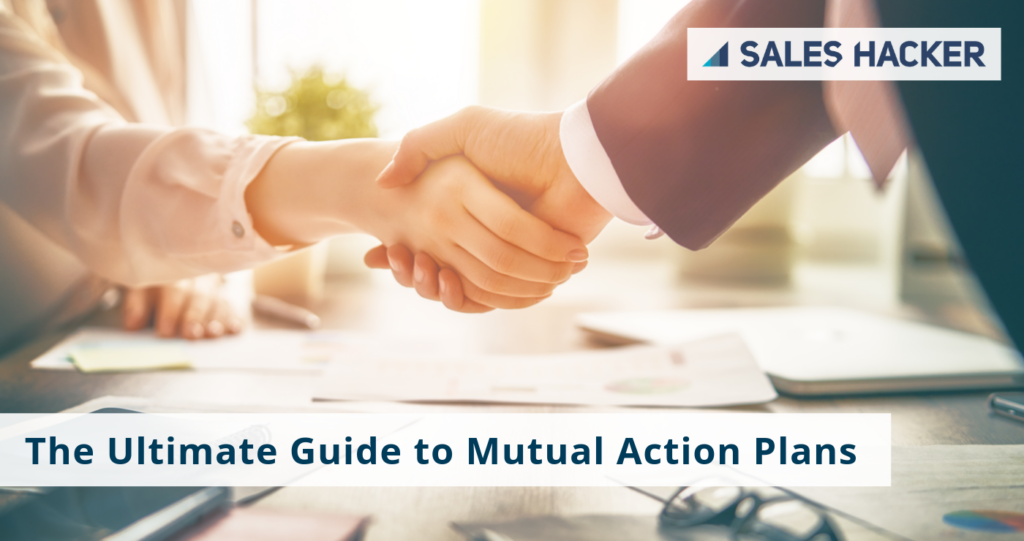Imagine knowing the actual close date of a deal months in advance…
Better still, imagine getting your prospects to tell you both who their key players are and all the gory details of their organization’s buying process –– and having it verified by the buyer before you even submit a proposal.
Think of the hundreds of hours you’d save chasing bad deals… the good deals you could stop from slipping into next quarter… and the trust you’d build by making your prospects feel they’re in safe hands.
You’d easily make your forecast the envy of the western world.
Think it’s a dream? Think again. Over the past 12 months, I’ve talked with hundreds of sales reps, sales leaders, and ops people about sales process, and a few patterns emerged.
One of the most consistent practices across top performers is collaborating with their prospects on a mutual action plan to get a deal from “Sure, that might work” to signed, implemented, and realizing value for both sides.
In this guide, you’ll learn everything you need to know about mutual action plans, from what they are to how you can use them in your sales process to save time and create more wins.
Let’s get started, shall we.
Related: How I Closed 50% More by Systematizing My Sales Follow-Up Process
Everything You Need to Know About Mutual Action Plans (MAPs)
- What Is a mutual action plan
- Why you should use a mutual action plan
- How to create an effective mutual action plan
- How to use a mutual action plan to improve your sales process
What Is a Mutual Action Plan?
The acronym for mutual action plan tells you exactly what it is –– a MAP. It’s a document that helps the sales team and a prospective customer work together to find a mutually beneficial solution.
The mutual action plan is known by a lot of different names, including mutual success plan, mutually agreed action plan, go-live plan, joint execution plan, and close plan. But regardless of what you call it, it always answers two important questions:
- Who needs to do what?
- When do they need to do it to make this deal happen?
This isn’t something that’s driven solely by the customer or the sales team. In fact, the reason it works so well is that it’s a collaborative effort.
You see, a well-written MAP has input from both the seller and the buyer. It identifies all the milestones that must be met to successfully implement the product or service inside the buyer’s organization.
Once created, it keeps both the selling team and buying team on track –– working together to punch through the list until the product/ service is up and running and delivering on the seller’s promise of value.
As you might guess, it’s an incredibly valuable tool. It serves both the buyer and the seller, protecting you both from guesswork and wasted time. Best of all, it helps you quickly identify a deal that could end up going nowhere.
But before we talk about how to create it, let’s get on the same page about what is a mutual action plan…
Why should I Use a MAP?
“It’s more about how detailed do you get rather than not doing one at all.” – Sarah Fricke, Global Sales Enablement Manager, RingCentral
Why should you use a Mutual Action Plan? The short answer is…
- At the highest level, mutual action plans help sales teams close more deals faster.
- They provide a better buying experience that differentiates them from the competition.
- They also give management significantly higher confidence in forecasts.
One caveat: While any deal is more likely to close if you have a mutually agreed plan for how it’s going to happen, most of the leaders we spoke with said it makes sense to make it formal when the deal reaches somewhere between $50K and $75K ACV.
That said, there are degrees. So on a $10K deal, perhaps you just share a checklist. And as the ACV increases, you put in more effort to make sure everything goes smoothly.
Now, let’s look at 4 top benefits of using a MAP.
1. Higher Close Rate
A MAP helps you win more details because it identifies the buyer’s process and stakeholders well in advance, so you can work through roadblocks before they become deal killers. A MAP also shows you far in advance when a deal isn’t viable, so you can disqualify faster and spend your time on deals that do have a path to success.
Sales rep Brittney Bartolini, of employee-recognition company Blueboard, pointed out that in addition to higher close rate, she sees average higher ACV (all-commodity volume) because the trust she builds up during the MAP process lets her skip over a pilot and go straight to a full-on implementation.
MAPs are valuable from an operations perspective as well. Sarah Fricke, of RingCentral, shared they recently moved to requiring MAPs to ensure their sales process was being followed properly, because deals that follow process are more likely to close successfully.
2. Faster Sales Cycle & Fewer Deals Slipping into the Next Quarter
“Reviewing the timeline line by line with their VP immediately kicked the sales cycle into a different gear as he realized how much there was to get done to hit his dates.” – Adam Heher, Director of Sales, Cloudability
We’ve all experienced the agony of watching a quota-critical deal slip inexorably past end of quarter. MAPs speed up sales cycles because there’s less time lost in “Oh, I was waiting on you,” or “I’m not sure who needs to sign that, let me get back to you.”
If you’ve anchored the deal close-date to a buyer initiative (see below for more on this) and put both dates on the mutual action plan, then you can show how the potential slippage puts their own initiative at risk, attracting executive attention, and getting things back on track.
RELATED: Stop “Closing” Your Prospects! Instead, Ask Them For The Next Step (Checklist)
3. Deliver Better Buying Experience
“No buyer will argue with clear expectations” – Tana McDermott, Vice President, Inside Sales at Workiva
With 7 people on a typical buying committee today, minimizing risk is one of the biggest factors in B2B decision making. More transparency makes it easier for buyers to trust their counterparts on the selling side, which reduces the risk of wasting time or, worse, being held responsible for a deal gone bad.
Buyers also report they appreciate the guidance a MAP provides: While you sell software everyday, the buyer has a day job. They may have no idea how their organization approves purchases, so the rep who can say, “This isn’t our first rodeo,” is much closer to being the trusted advisor every buyer seeks.
Plus, a good MAP means less actual work, since it’s clear who needs to do what at every stage of the deal.
4. Better Forecasts & Deal Coaching
The fastest way to get fired as a sales leader is bad forecasting. The entire org depends on knowing what they have to work with, so if you’re not going to hit your number, it’s better to know sooner and avoid blindsiding the management team on the last day of the quarter.
If you know the status of mutually agreed milestones leading up to an externally-driven, mutually agreed compelling event, the forecast is going to be more accurate, answering both “will this deal close” and “when will this deal close”.
Finally, measuring buyer progress against milestones is a great construct for deal reviews, allowing you to spend less time fact gathering and more time coaching through the potential roadblocks uncovered by the MAP.
Who knows, you may even be able to dump that secret Excel spreadsheet where you handicap each reps’ forecast ability.
Breaking Down a Mutual Action Plan
Now, let’s break down the elements of a mutual action plan. In this section, we’ll outline the core elements of an effective mutual action plan and share tips for developing a winning MAP.
Keep in mind, no single template fits every use case, so please feel free to mix and match these elements to be whatever is most helpful for your buyers.
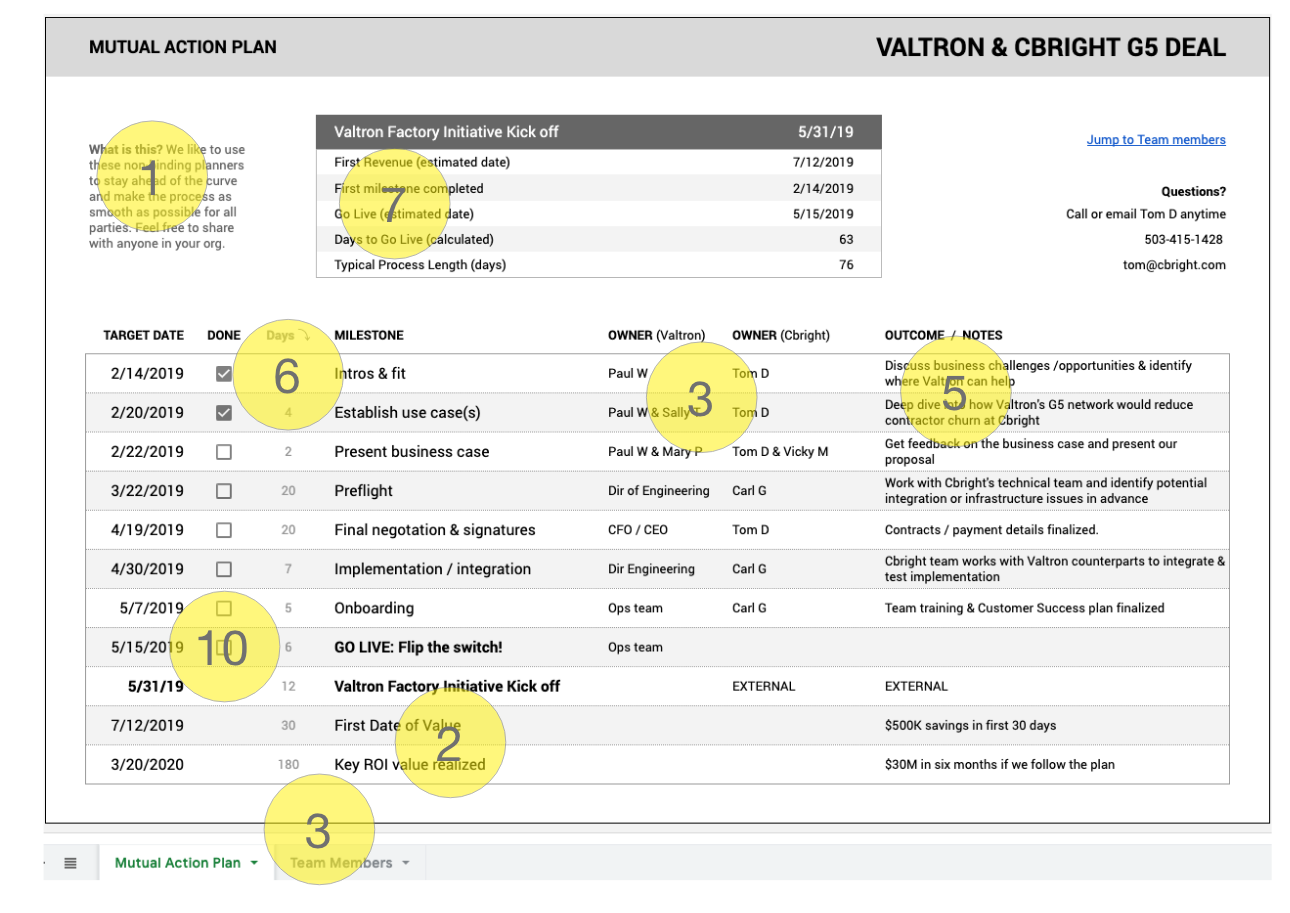
- Value summary
- Buyer-centric finish
- Milestone ownership
- Buyer and seller teams (not shown in the image above)
- Outcomes
- Duration
- Key dates
1. Value Summary: Why are we working on this again?
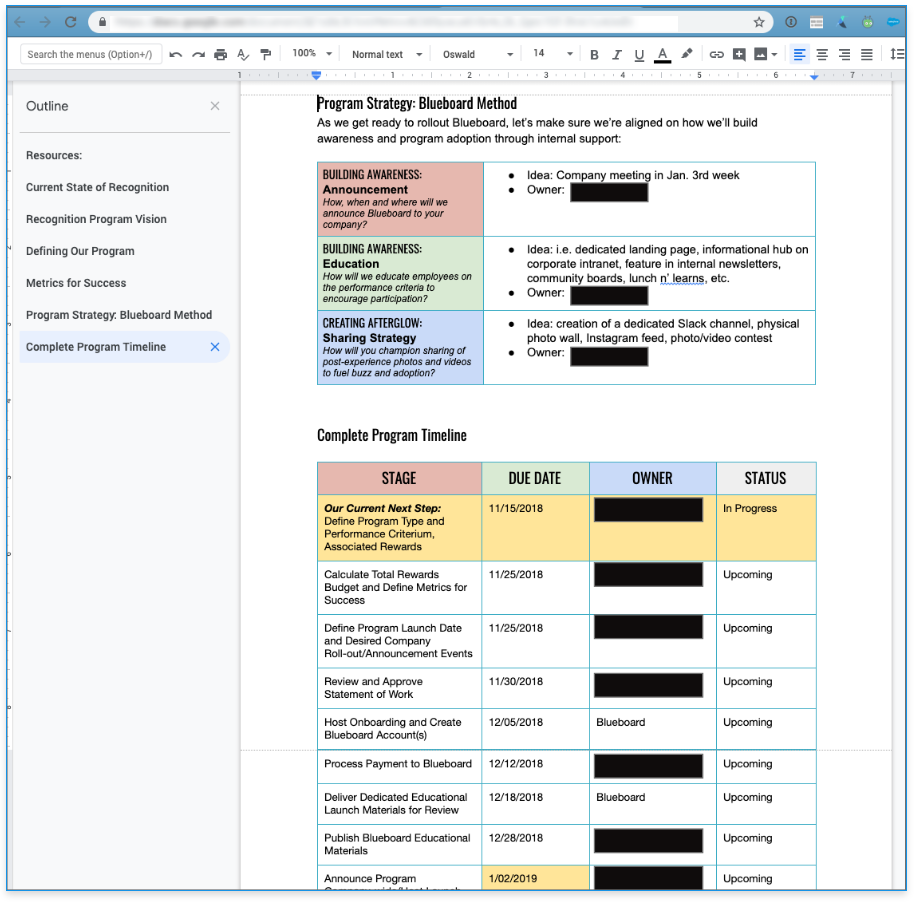
This letter-format MAP is easy to digest and share with executives.
Notice it leads with a narrative value summary. This is especially helpful to senior decision makers who only get involved in the latter stages of a deal. Since they don’t always have the benefit of the early discovery meetings, a summary gets them up to speed quickly.
On a side note, these “non-believers” are the ones most likely to kill your deal, so you need to leverage every chance you can to remind them of the immense value this solution is bringing to their organization.
2. Buyer-Centric Finish: Contract is just a means to an end
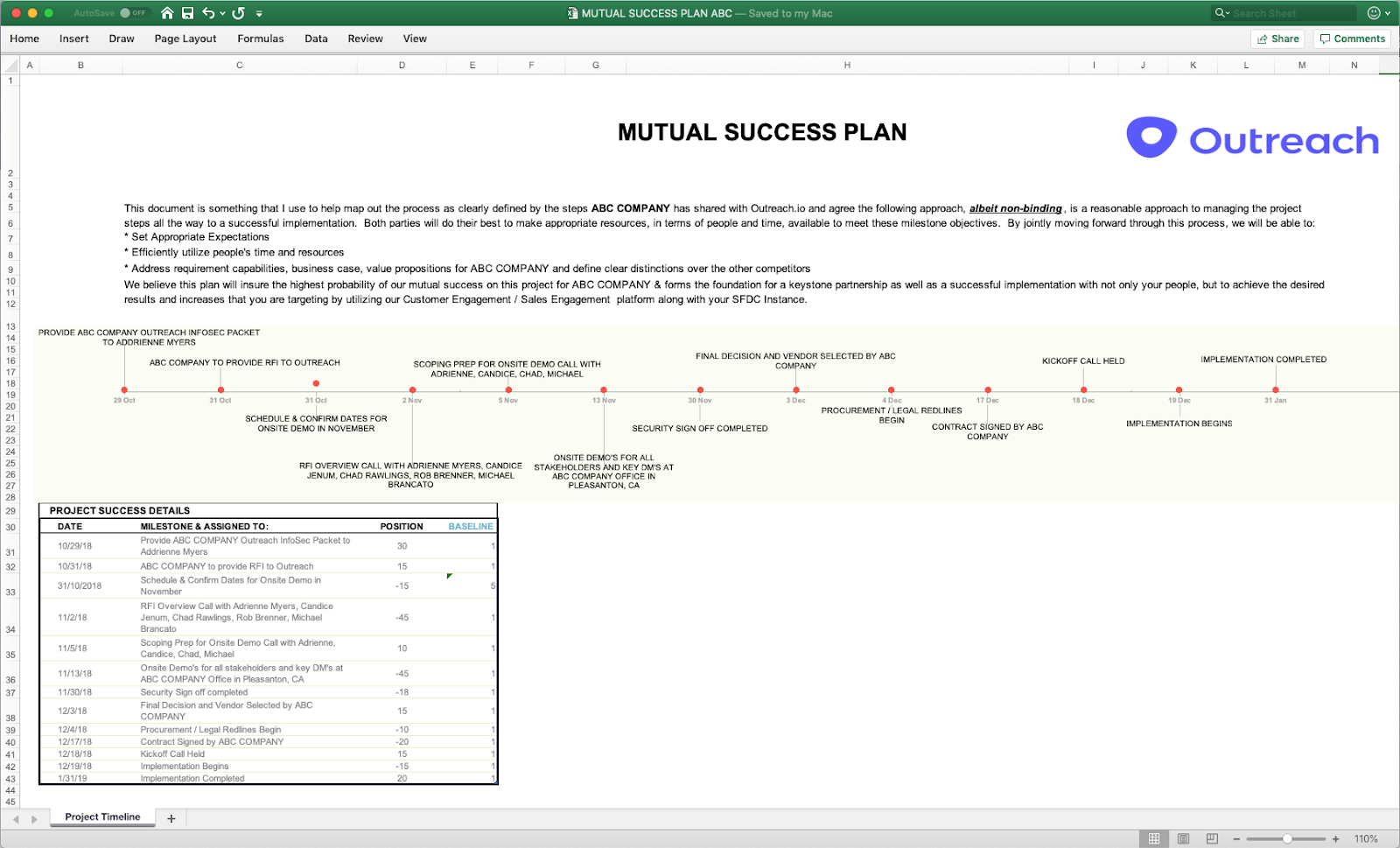
Too many Close Plans conclude with “Contracts Signed.” This is seller-centric behavior at its worst.
The best MAPs, like this one from Outreach, continue beyond contracts and focus on the buyer’s outcome –– ideally ending at your buyer-driven compelling event or, at the very least, onboarding and implementation.
This accomplishes three things:
- Keeps the focus on the benefits to the customer and makes the contract just a means to an end
- Maintains urgency as you push up against external deadlines
- Allows a silky smooth hand-over between Sales and Customer Success
One nice variation that Emma Weir, of Cornerstone OnDemand, includes is to add “Time to Revenue” as the final milestone in the process. This simple addition draws a direct line between the milestone you’re working on now and the glorious potential future you’re selling.
It also makes date slippage more painful, because every day missed now pushes that revenue out further.
3. Milestone Ownership: Accountability goes both ways

Nearly all MAPs have a place to assign the people responsible for each milestone, either embedded in the milestone description or in a separate column.
Some MAPs go a step further, with one column for the Buying Team and one for the Selling team: Having two names on a milestone highlights that each side is accountable and both sides have to contribute to make things happen.
Be aware, sometimes, you don’t know the names of the responsible people. When that happens, include the role of a milestone’s owner.
Side Tip: Don’t leave out the work you’re performing as the sales rep. When buyers see that you’re investing time to make this deal happen, they become more committed. They’re less likely to go dark.
4. Buyer and Seller Teams: A killer discovery aid
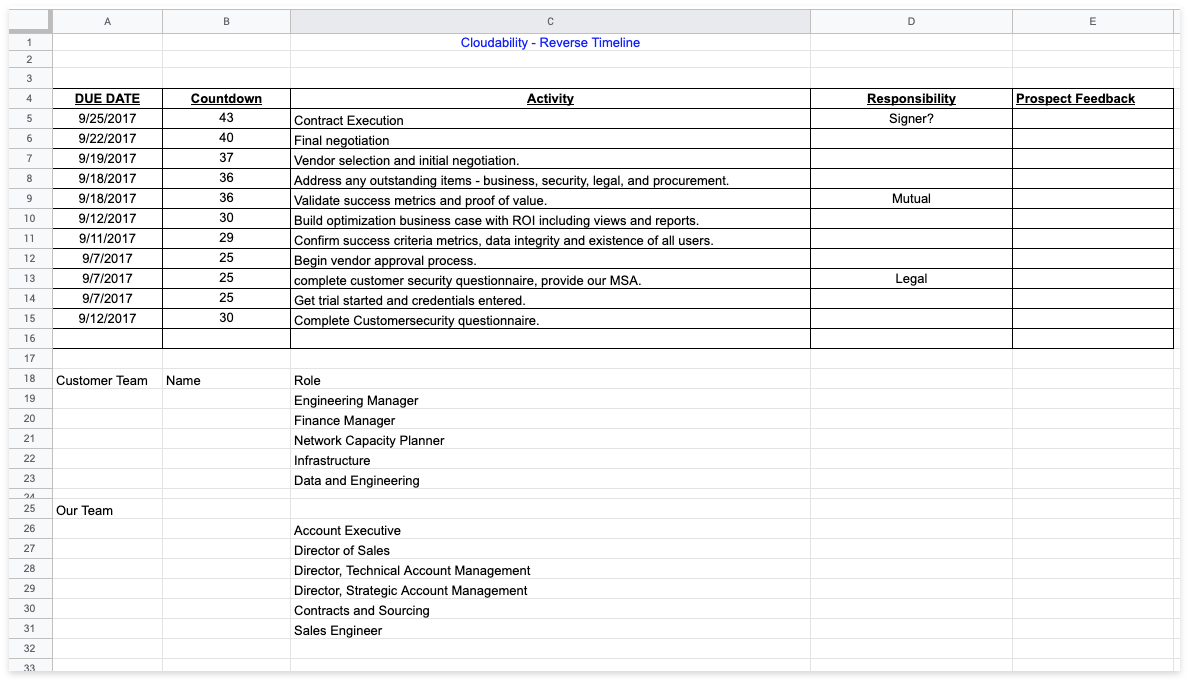
As we just mentioned, the MAP is the perfect place to call out and identify the deal’s stakeholders. But it can also be a powerful discovery aid.
Note how this MAP from Cloudability lists the anticipated roles even before a name has been identified. This drives the conversation with your champion to help fill in the rest of the decision makers –– and if they can’t or won’t help you, then that’s a major red flag.
Note also how Cloudability includes details about the selling team. This accomplishes three goals
- Builds trust by sharing your boss’s contact info
- Demonstrates the selling team’s deep bench to minimize risk in the eyes of the buyer
- Assures smooth handover by introducing account managers (or Customer Success) early, so buyers don’t feel like they’re thrown over the wall once the contract is signed.
5. Outcomes: The devil in the details
Very few things in life are black and white, so it makes sense to capture the outcomes of each stage rather than simply marking them DONE or NOT DONE.
You might be recording this detail already in your CRM, but sharing a summary with buyers via the MAP ensures that you’re both on the same page and that the buyer endorses your characterization of everyone’s progress.
Cloudability (see example above) captures Prospect Feedback right in the timeline. By using a Google Sheet, the buyers can input and update this info themselves, so the details come straight from the horse’s mouth.
6. Duration: Are we there yet?

Tracking expected duration of each milestone shows you know your business and makes it less likely that you or the buyer have arbitrary or unrealistic deadlines for specific milestones.
If you’re using a spreadsheet, duration can drive estimated dates with a pretty simple cell calculation.
7. Key dates: Keep their eyes on the prize
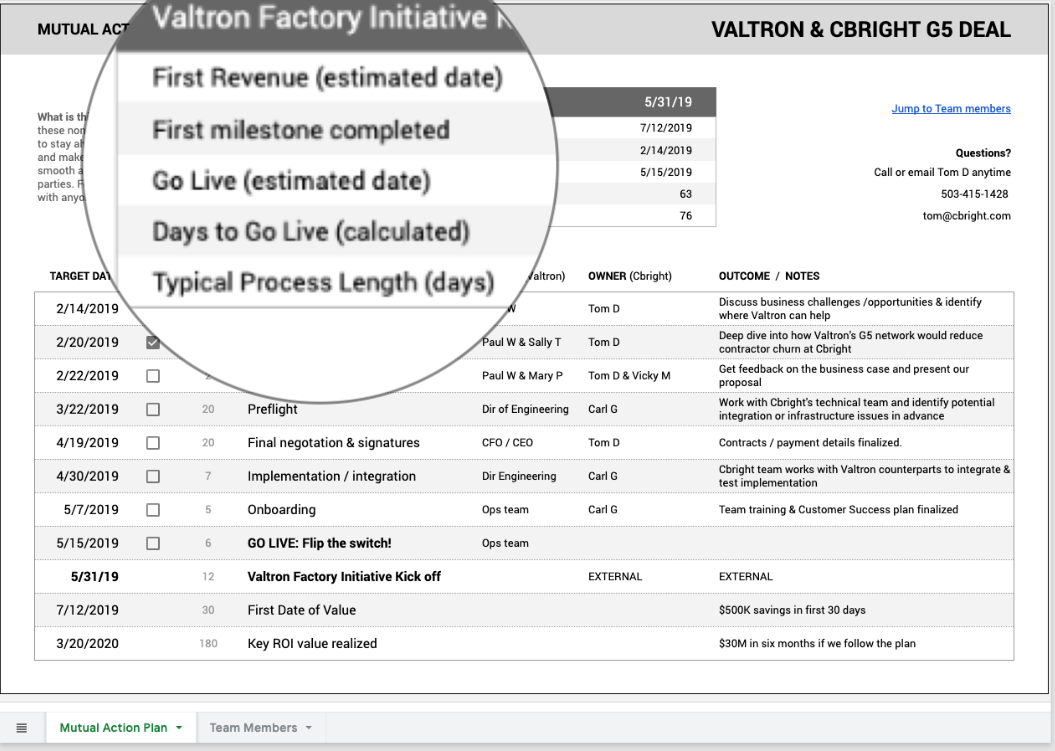
You never want the customer to lose sight of the life-changing transformations they’re going to experience when the deal is done. A simple way to do that is to give them a concrete date for when their new solution will be up and running.
You can keep the blood pumping and drive mutual accountability by including a summary of key dates along with the value prop. If you’re using a spreadsheet and you really want to induce urgency (or panic), include a real-time countdown to the compelling event.
8. Signatures: Maybe Too Much Too Soon
A couple of people shared that they included a signature block for buyers to sign off on a mutual action plan.
In my opinion, this is going too far and may scare off a prospect. After all, there’s plenty of time for binding signatures when you’re negotiating the actual contract.
In fact, I like subtleties like this example from Outreach. Notice how they explicitly state that the MAP is non-binding.

9. How many steps: Goldilocks zone
Most MAPs have between 8 and 12 line items.
While you want to set clear mutual expectations as early as possible, there is a risk if you present everything to a buyer too early –– specifically, before they’re fully onboard with the value proposal.
Don’t overload them with unnecessary details, or you’ll scare them away.
One approach that can help you avoid this is to wrap smaller “outcomes” into larger “milestones” and present only the high level milestones at first, with the ability to drill deeper as you get closer. That requires more sophistication in the template, but it can help you deliver a MAP that’s “just right” for the buyer’s stage of commitment.
10. Format Wars: Spreadsheet or doc? Or both?
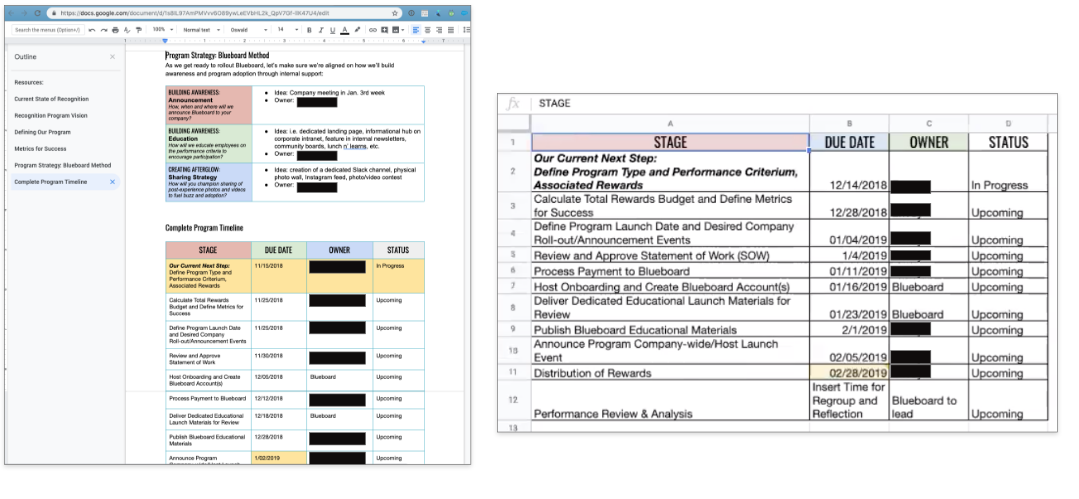
This is the great divide. Do you present your MAP as a spreadsheet or narrative doc with a table… as a PDF or online share?
The obvious benefit of sharing an online doc is it’s always up-to-date. But a one-page PDF can be much more visually attractive and ready for senior executive consumption.
Ultimately, the best solution is something that Sarah Fricke from RingCentral and Brittney Bartolini of Blueboard recommend: Different buyers have different needs, so support different formats and give each buyer the format that best fits their needs.
Don’t know which one is best? Ask them.
Leveraging your Mutual Action Plan For Day-to-Day Best Results
Now that you have the perfect template, it’s time to put it to good use. Here are 4 tips to do just that.
1. Make It Mutual
“Buyers buy into that which they help create.” – Chad Rawlings, Director of Sales, Outreach
Mutual involvement is the single biggest indicator of a MAP’s chance of success.
Look for the buying team to engage with their milestones and put time into understanding and customizing your template for their organization’s buying process.
They have to sign off on your value prop and share enough internal information for you to establish a compelling event, and they need to be willing and able to bring the right people to the table.
Once the timeline is set, buyers must continue to commit to the next step, and if they don’t, look for the disqualify.
2. Create Urgency with a Workback Exercise
The workback is most effective if you’ve successfully identified an externally driven buyer initiative as your compelling event. But even if you can’t find that perfect buyer initiative, you can still work back to create a sense of urgency.
The goal is to take their target launch date, then start working back with the steps needed to get the deal signed and the solution up and running.
If you’ve got your milestone duration numbers right, chances are the first milestone is due pretty soon. That helps you get the ball rolling now, so the buyer can launch in time to meet that compelling event. (Tell them if they don’t, your org’s going to fail at that initiative and everyone’s gonna die.)
“I’m not calling to follow up”…
After you use the workback to kickoff now rather than later, you can maintain urgency by referring back to the timeline.
So instead of calling “just to follow up” you can say, “You told me this compelling event was important to your success, and we agreed the steps and timeline to make it happen with the help of our solution. We’re at risk of failure because we’re falling behind on X milestone. How can we get back on track so you don’t die?”
3. Introduce the MAP Early and Share It Wide
Opinions vary here. Sales strategist Alice Heiman recommends waiting until the buyer agrees there’s a fit and you’ve identified budget. She does add, though, “You’re having a conversation, so introduce the MAP when it fits.”
Tana McDermott introduces informal next-steps early on, then gets more formal at the proposal stage. Other experts recommend introducing the MAP as early as possible.
For most deals, the “right time” is going to be some point after you’ve got buy-in from your champ, but before you’ve invested your own valuable resources (and definitely before you go down the procurement rabbit hole).
Keep in mind, too, that your buying team extends beyond your champion. It may not be politically wise to email the entire buying team every time there’s an update, but you should do your best to make sure every stakeholder is aware that this document exists.
4. Don’t Fear the Disqualify (DQ)
If your champion continually fails to meet the commitments they agreed to as part of the MAP, give them the opportunity to adjust the timeline, or go over their head to see if their boss is willing to let it fail as well.
If no one is willing or able to revise the timeline, kick these time-killers to the curb and prospect yourself a new opportunity.
RELATED: Disqualifying Prospects: 50+ Sales Leaders Share their Best Methods
Enough Talk. Time to Mutually Act.
I hope this overview has given you some ideas on how mutual action plans will help improve the lives of both your buyers and your sales team:
- Improve your buyers’ buying experience by enabling easier process and reducing risk
- Improve your team’s forecast & win rate by capturing buyer engagement and opening up stakeholder awareness
Just remember…
- You have to actually make it mutual. Otherwise it’s just a wish list.
- Keep everyone’s eyes on the prize by having the final step focus on buyer value, not closing the contract.
If we had a mutual action plan governing this conversation here today, I’d make your next step be: Talk with your top producers and see if there aren’t already some unofficial MAPs floating around your organization.
Then in my column of responsibility, I’d be asking for feedback on whether this article was helpful to you.
So let me know by leaving a comment below. Did you learn something new? Have you had good success using mutual action plans in your sales process?
One more thing…
You’re welcome to adapt this template for your own org.
